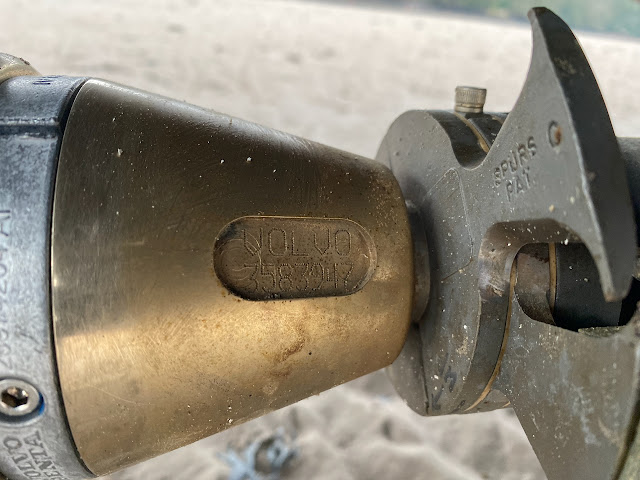Morar Sands - 56° 58' 11" N 05° 50' 15" W
 |
| Anchor nicely dug in |
It's that time again.
For some reason, the metallurgy of which we don't understand, the anode on our propellor initially lasted a mere three months before they required replacement. If you recall our blog post back in February when we dried out at Sandy Haven, our anodes were mostly gone. We had been assured that this rate would slow down over time but we were anxious to check/replace them again after three months.
With the water still very chilly and the cost of lifting the boat significant, the easiest way was to dry out once more. Thanks to OCC member Phil, we were able to scout the location and plot out where to anchor on our charts by going to Morar Sands at low tide the day before.
 |
| Glorious day to dry out - we could have been in The Caribbean! |
We left Mallaig about 7:30am, in time to anchor in our 'spot' on the falling tide. We opted not to use a stern anchor to hold the boat facing up the beach due to it being a glorious day with next to no wind.
The process of drying out is very slow-motion exciting. You wait for a high tide, then sail/motor into a ridiculously shallow area, drop your anchor with a very small amount of chain (keeping you inside of a tight perimeter). You then need to pull out the speed/depth sensor from the bottom of your hull, as resting on that could very likely damage it. You now have no way of determining EXACTLY how close the bottom of your hull is to the ground, so you just wait.
And wait.
After an hour or so, you notice that the gentle, swaying from the wind action on your floating home isn't happening. A quick look over the toerail confirms that the water surface is noticably lower than it normally is. Sure enough, the boat feels less 'floaty'. After 25 minutes, we were setting on quickly-draining sand.
Rather sadly, just as Chinook touched the sand, a breathe of wind blew her around so we were across the beach landing her at a jaunty angle. Still very safe and we could access her underside and propellor but it mean our photos were not quite of an Instagram quality!
 |
| That's quite the slope behind Chinook! |
 |
| A better view of how easy it is to access the undersides. |
We took the opportunity of having the dry hull to give the bottom a good scrub, removing the normal growth that happens on boats. We also inspected the rudders, prop and anodes.
 |
| The indented ring around the bronze prop shaft is where the anodes are. They seem to be mostly corroded away. Good thing we checked! |
 |
| Cleaned up and ready for the new anodes. |
 |
| New zinc anodes in place. |
We are very pleased to report that we had about a third of each anode were left, so the rate of erosion is reducing. That's great news as we head into The Baltic Sea where the tide ranges can be measured in millimetres rather than metres! It will be much harder to dry out there.
We had a few people come out to walk by Chinook under the guise of walking their dogs, but we suspect it is an unusual-enough sight to have a 14 tonne boat sitting on the sand to warrant an investigation.
We like the novelty of walking ashore to have our lunch.
 |
| Keeping an eye on the boat. |
 |
| Morar Sands - the Harry Potter train could be seen puffing along in the background |
While we waited for the tide to come back in and float Chinook, we explored around the beach and enjoyed the sunshine. Once we had enough water to leave, we set sail (yes, we did actually sail) across the sound to the Isle of Rum.
 |
| Looking across the Sound of Sleat to the Isles of Eigg and Rum |
And please remember that Blogger posts your comment as anonymous if you don't have an account, so please sign off with your name so we know who you are!
Comments
Post a Comment